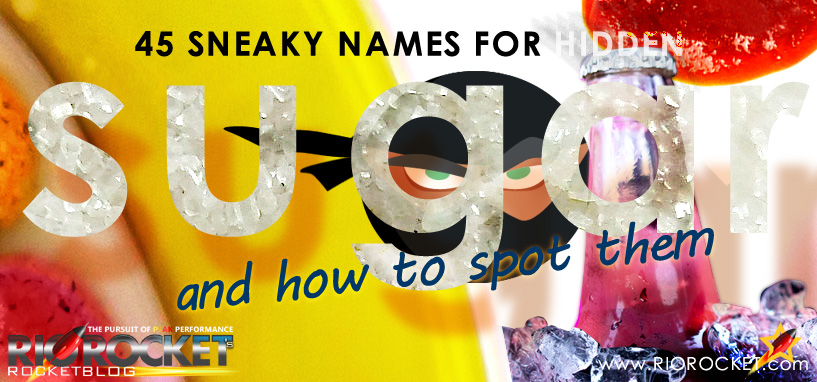
All Graphic Design by Rio Rocket
[dt_divider style=”thin” /]
45 Sneaky Names For Hidden Sugar
You don’t need me to tell you that added sugars can negatively impact your health and that processed sugar is toxic for your body. Even ingredients with naturally occurring sugars such as honey and agave must be moderated.
Not only does a high daily intake of sugar lead to unwanted weight gain but processed sugar in particular is linked to diabetes, heart disease and the proliferation of cancer cells. We’re taking in more sugar than we even realize. Not cool.
So how is this happening? Manufacturers have developed over 200 sneaky names to hide sugar in your food and beverage products. Here are the 45 most common sneaky names for hidden sugar and how you can spot them a mile away. We’ll start with the blatantly obvious first as we progress toward the more sneakier ninja-like variants.
[clickToTweet tweet=”45 Sneaky Names For Hidden Sugar and how to spot them! – Rio Rocket” quote=”45 Sneaky Names For Hidden Sugar and how to spot them! – Rio Rocket”]
Hidden Sugars by Groups
Group 1 is easy to spot. Any ingredient that appears to be a healthier alternative of sugar just simply isn’t…your body still processes these as it would with normal ‘sugar’.
1. Beet sugar
2. Brown Sugar
3. Cane sugar
4. Coconut sugar
5. Coconut palm sugar
6. Confectioner’s sugar
7. Demerara sugar
8. Date sugar
9. Fruit sugar
10. Grape sugar
11. Invert sugar
12. Palm sugar
13. Raw sugar
14. Turbinado sugar
Group 2 is somewhat easy to spot but it’s not always obvious that they’re quite unhealthy.
1. Brown rice syrup
2. Carob syrup
3. Corn syrup
4. High fructose corn syrup
5. Maple syrup
6. Rice syrup
7. Refiner’s syrup
8. Sorghum syrup
The mere mention of “juice” hints at processed juice concentrate loaded with sugar.
1. Cane juice
2. Evaporated cane juice
3. Grape juice concentrate
Ingredients that allude to things that we know are sweet, sound sweet or contain the word “sweetener”. Even if the ingredient contains naturally occurring sugars it is still processed in your body as sugar and should be moderated accordingly.
1 Agave
2. Blackstrap molasses
3. Caramel
4. Corn sweetener
5. Honey
6. Maple Syrup
7. Barley malt
The secret order of ninja ingredients you either can’t pronounce or sound otherworldy.
1. Diatase
2. Dextrin
3. Dextrose
4. Diastatic malt
5. Fructose (High Fructose Corn Syrup)
6. Galactose
7. Glucomalt
8. Glucose
9. HSucrose
10. Lactose
11. Maltose
12. Saccharose
13. Treacle
The 5 Most Commonly Used Sweeteners
[join-after-post]
The Top 5 Sources of Added Sugars
Offset by: Drinking much more water.
The 8 glasses a day rule is an outdated recommendation from 1945 when the Food and Nutrition Board, which became part of the Institute of Medicine (IOM), which is now the National Academy of Medicine – recommended we consume one milliliter of water per calorie of food consumed. Therefore an average diet of 1,900 daily calories would suggest we drink 1,900 ml of pure water. This doesn’t take into account the water content in other liquids and foods we consume.
Today, it is recommended we consume an even higher total daily water intake. 3.7 liters (15 cups) for the average adult male and 2.7 liters (11 cups) for the average adult female. These numbers will always vary according to the age, activity level and climate the person lives in. The average person will remain hydrated at levels below these recommendations so adjust your water intake accordingly based on your activity levels, climate and amount of water based foods you consume.
Offset by: Eating more fruit.
If you have the need to satisfy a sweet tooth then no better way to do it with delicious juicy fruit which contains natural sugars. Although fruits contain small amounts of sugar they are high in fiber, nutrients and other beneficial compounds.
Offset by: Keeping to a minimum.
If dessert is your thing then I’m not about to try to talk you out of cutting out dairy desserts entirely. It is best to limit your consumption and try to find healthier alternatives/versions such as sorbet, yogurt, yogurt parfait, kefir and puddings. Halo Top is also a reasonable low-sugar, low-carb, low-fat alternative.
Offset by: Chewing gum with Xylitol
Candy is a sugar confection that features sugar as its primary ingredient. It includes chocolate, gum, marshmallows, taffy, caramels and any of the many varieties of sugar candies. It has become so popular in our culture that even vegetables, fruits and nuts that are glazed/coated with sugar are said to be candied.
The best alternative is either dark chocolate or chewing gum that contains Xylitol instead of sugar which is explained in the section below titled “What is Xylitol?”
Offset by: Eating oats sweetened with Stevia and cinnamon.
The word cereal is derived from Ceres, the Roman goddess of harvest and agriculture. A cereal is just simply any grass cultivated for the edible components of its grain but unfortunately most commercial breakfast cereals are brightly colored and sugar-laden to offer curb appeal to passerby supermarket shoppers. Even the cereals with healthy claims of fiber and potassium on the market still contain as high as 38% of calories from sugar. Too much.
One of the few things that is healthy and found in a cardboard box are oats and one of the healthiest methods to sweeten oats is with a natural sweetener known as Stevia which is explained in the section below “What is Stevia?”
[join-after-post]




Good read, Xylitol also aids in preventing cavities.